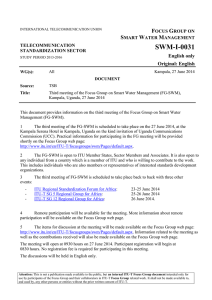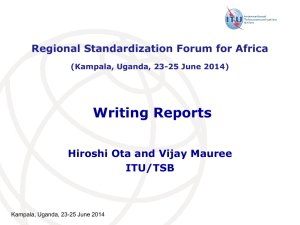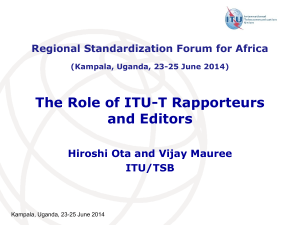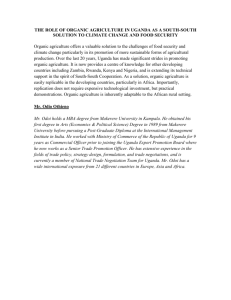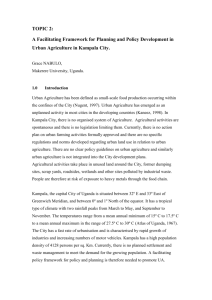Drafting Recommendations Hiroshi Ota and Vijay Mauree ITU/TSB
advertisement
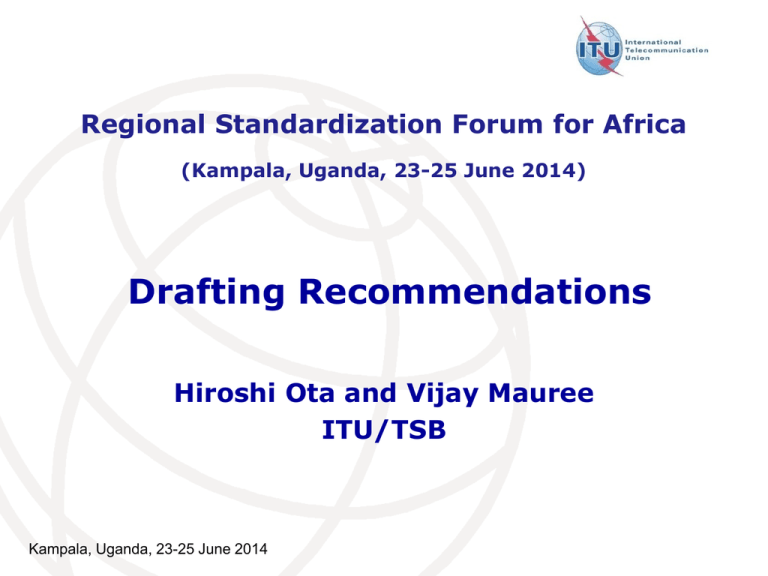
Regional Standardization Forum for Africa (Kampala, Uganda, 23-25 June 2014) Drafting Recommendations Hiroshi Ota and Vijay Mauree ITU/TSB Kampala, Uganda, 23-25 June 2014 Outline General Comments Work Flow from beginning to end Format of ITU-T Recommendations Kampala, Uganda, 23-25 June 2014 2 General Comments on drafting Recommendations - 1 Think about the study Question and what Recommendations it identifies Write clearly; write concisely Recommendation should say what to do, without lengthy explanations of why to do it Understand the difference between “should” and “shall” Make sure these are used as intended Kampala,2014 3 General Comments on drafting Recommendations - 2 Provide good estimates of your goals for the Work Programme Database Expect and plan to include editing from the very beginning Editing at the end will lead to inadvertent changes of substance Seek help Assign sections to different experts and sub-groups, as needed Kampala, Uganda, 23-25 June 2014 4 General Comments on drafting Recommendations - 3 Work closely with your Counsellor, especially with respect to the version of the text to be used Read and be familiar with the: Author’s Guide for drafting ITU-T Recommendations English Language Style Guide Become familiar with the Terms and Definitions Database Kampala, Uganda, 23-25 June 2014 5 General Comments on drafting Recommendations - 4 Keep track of other standards being incorporated in the draft Recommendation Use the e-tool that will generate the TD documenting ITU-T A.5 justification Access the e-tool from draft Rec page in the Work Programme database This mandatory document is needed before CONSENT or DETERMINATION can be done Applies to all normative References Kampala, Uganda, 23-25 June 2014 6 General Comments on drafting Recommendations - 5 Engage native English-speakers in an editorial group Ensure your list of collaborators is up to date, including individual experts who might not be ITU-T members When editing between meetings, make new text available well before next meeting to allow members time to examine and comment Kampala, Uganda, 23-25 June 2014 7 General Comments on drafting Recommendations - 6 Be at all relevant meetings Meet your commitments and dates Dates to produce clean edited texts after meetings Dates to submit documents before meetings Some are out of consideration for your collaborators Some are required by ITU-T procedures Kampala, Uganda, 23-25 June 2014 8 The work flow-beginning to end 1 With consultation, decide what (family) of Recommendations need to be developed Plan a work schedule and get it agreed How many meetings Time between meetings Leave time for experts to work between your meetings Can start with the objective end date and work backwards to plan meetings and set milestones Kampala, Uganda, 23-25 June 2014 9 The work flow-beginning to end 2 Plans can include both e-working and physical meetings: Remember there are meetings of the Question during SG/WP meetings Arrange for meeting hosts Expect that rapporteurs and editors will host some of the meetings Establish a collaborators list Work with TSB Report it to each WP/SG meeting Kampala, Uganda, 23-25 June 2014 10 The work flow-beginning to end 3 Start with Recommendation Template Fill in known sections Consult the Terms and Definitions Database early Some text is boilerplate Some text will be from RG agreements Identify gaps and items For Further Study (FFS) Move ahead, not backwards, at each meeting Kampala, Uganda, 23-25 June 2014 11 The work flow-beginning to end 4 As work progresses: Use English Language Style Guide Stay close to TSB Consult, consult, consult Collect ITU-T A.5 information Keep WP Chair informed, especially when you anticipate seeking CONSENT or DETERMINATION Have final edited text ready quickly after CONSENT/DETERMINATION Kampala, Uganda, 23-25 June 2014 12 The work flow-beginning to end 5 Be available for the approval process You will be intimately involved during AAP Last Call AND Additional Review AND Study Group Decision meeting, or During TAP comment resolution before AND during the SG Decision meeting Be available for publication activity For consultation on editorial clarifications requested by TSB These apply to both Rapporteurs and Editors Kampala, Uganda, 23-25 June 2014 13 Format of a Recommendation – see Author’s Guide Cover Page - Provided by TSB Title Number - assigned by TSB after approval Date of approval Text of title Summary drafted by Rapporteur/Editor mandatory MUST be provided before CONSENT or DETERMINATION begins approved by SG History provided by TSB Kampala, Uganda, 23-25 June 2014 14 Recommendation Summary Summaries posted in all 6 languages Users will look at a Summary to decide if it is of interest to read the whole Rec Summary should be clear, concise and informative Example of a bad Summary: “The following text reflects the agreed modification for a second amendment to Rec. ITU-T XXX. The text modifications are shown with revision marks.” Kampala, Uganda, 23-25 June 2014 15 Format of a Recommendation Forward Boilerplate Provided by TSB Not part of Rec Note, IPR, © Boilerplate Provided by TSB Not part of Rec Kampala, Uganda, 23-25 June 2014 16 Format of a Recommendation Keywords Optional; not part of Rec Introduction Optional; not part of Rec Provided by author Pages numbered with lower-case Roman numerals Table of Contents Provided by TSB but helps if one is included in editor’s drafts Kampala, Uganda, 23-25 June 2014 17 Format of a Recommendation Clause 1: Scope Clause 2: References Boilerplate text followed by list of normative references used in the Rec References are standards of accepted bodies Remember: Will need ITU-T A.5 justification Reference to a document does not give it the status of an ITU-T Rec Must have Clause 2 even if it is blank Include an appropriate indication that the clause is intentionally left blank Kampala, Uganda, 23-25 June 2014 18 Format of a Recommendation Clause 3: Definitions Terms defined elsewhere Terms defined in this Rec Clause 4: Abbreviations and acronyms Do not use abbreviations in title of Rec Indicate if it is left blank Clause 5: Conventions used in Rec To describe particular notations, assumptions, styles, etc. used in Recommendation Indicate if it is left blank Kampala, Uganda, 23-25 June 2014 19 Format of a Recommendation Clause 6 and on: Text of Rec Annexes Designated by capital letters (A, B, …) Form an integral part of the Rec Appendices Designated by upper-case Roman numerals (I, II, …) Not a normative part of the Rec Electronic attachments Can be a clause in main body, annex, etc Kampala, Uganda, 23-25 June 2014 20 Format of a Recommendation Bibliography Optional Cite informative references or sources Referencing draft standards and internal ITU documents (e.g., contributions, TDs) shall be avoided Do not abuse Bibliography Index Optional; not commonly used Reference to clause number, not page number Kampala, Uganda, 23-25 June 2014 21 Format of a Recommendation See the Author’s Guide for drafting ITU-T Recommendations for guidance on: Fonts Clause numbering and titles Mathematical expressions Figures and tables Notes and footnotes See Rec ITU-T A.23 for formatting of Common Text Recs prepared with ISO/IEC (e.g., Annex, Appendix are different) Kampala, Uganda, 23-25 June 2014 22 Additional Guidance in Author’s Guide Annexes Annex A: Revision to existing text Annex B: Development of definitions Annex C: URI structure used in Recs Annex D: Actions required to improve quality of ITU-T Recs Mandatory check list for Rapporteurs before submitting draft Rec for approval process Annex E: Presentation style of amendments and corrigenda Kampala, Uganda, 23-25 June 2014 23
